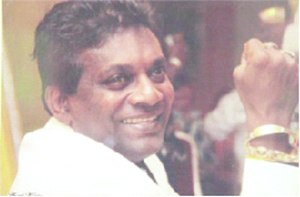A slender, supple magician behind the shaky wooden counter, the venerable spice master spoke in soft swishes of silken sound, silvery smooth like his slick hair separated at the side, but with eyes smouldering behind thick glasses. He would stare at us intently for a second, smile and saunter across to cast his spells, gently conversing with my mother about her planned purchases.
Tiptoeing, I would glimpse his white shirt tucked into far too big, belted trousers, and gaze enraptured at the enamelled, brightly flowered bowls of bounty,  that sat tantalizingly close just beyond my hands. Never far from the nose, the mysterious melange would spread its sharp, subtle, strong, sweet scents, singing of strange sagas, sailing ships and seasons past, wafting up exotic imagery in intoxicating, invisible and irresistible tendrils, through the cool morning air.
that sat tantalizingly close just beyond my hands. Never far from the nose, the mysterious melange would spread its sharp, subtle, strong, sweet scents, singing of strange sagas, sailing ships and seasons past, wafting up exotic imagery in intoxicating, invisible and irresistible tendrils, through the cool morning air.
Ridged balls of black pepper and petite, piquant coriander; elegant, greenish gray cumin/geerah; tiny, tangy rectangles of yellowish-brown fenugreek/methi; light and dark mustard seeds rolling around in merriment; shining triangles of harsh nigella/mangrile favoured as an asthma and hypertension cure; hard golden turmeric roots twisted in bizarre contortions; dried mild, curling, curry leaves; thin tight rolls of real cinnamon; stubby cassia sticks; exhilarating clove slips like upturned exclamation marks; fragrant fennel/saunf; zesty carps of carom/ajwain; aromatic and expensive elaichi/cardamom pods; gleaming nutmeg, lacy mace.
These were the timeless treasures tucked into the little stall in a corner of the La Penitence market, each a customary treatment for a range of ailments ranging from high cholesterol, gas, heart disease to cancer, arthritis, stroke and skin diseases.
Perhaps from the pharmacopeia there would be a boisterous madras meld for meat curries, a garam (peppery/warm) masala version for chicken, another infused with slices of sour, dried mango or bilimbi for seafood; rock-salted tart “chaat” concoctions to be liberally sprinkled on to refreshing fruits/veggies as a salad or crunchy first course, and on special days, a more precise package with a preponderance of the bitter and searing spices for an array of “achaars/amchars,” uncooked “kuchelas” (grated, cut fruit preserved in spices and oil), powerful pickles and cheerful chutneys.

I would be transfixed by his long fingers flicking a bit of this and that, pausing slightly, twirling from one container to the next, and finally tossing it all, with a flourish, in a crescendo, on to the metal scale and then quietly, carefully wrapping the prize in a parcel of paper.
We were taught to sort and then slowly roast the mix of spices in an iron pot over a low fire, to enhance the medley of flavours, before these were patiently ground on a stone sill for each meal. Some were done dry, most were welded into thick, virescent or sepia pastes with fresh chives, red peppers, garlic, onions and green herbs depending on the dish, to be thoroughly sauteed or served straight.
Glistening jars crammed with lime quarters scalded until soft with starry flecks of scarlet habaneros would stand like sentinels on the stairs, curing in the sun. But it was the sheer terror of the smoking “achaars” that would send me racing for cover, out of the house and far down the road. Coughing, sputtering, gasping from the deadly combinations of blistering chilies and mustard oil on high fire, my eyes competing to run, I would scamper away, holding my throat, sinuses instantly cleared, and return much later, cowed, to find the house reeking from gate to bedroom.
A collection of “chokas” (mashed/pounded vegetables) and mostly savoury chutneys could be easily created from tomatoes, eggplants, starchy tubers, wedges of creamy coconut seared on an open flame, browned peanuts and nutritious sesame seeds. This versatility and meld therefore lent the latter’s tasty title to a new genre of music indigenous to the southern Caribbean, perennially popular in Guyana, Suriname and Trinidad and Tobago (TT), and now further afield in North America and Europe, wherever descendants of the original Indian indentured labourers mostly from Bihar and Uttar Pradesh, have further migrated.
Believed to be an offshoot of the scathing social verses and oft-raunchy mocking lyrics brought by the immigrants to the West Indies, the basic chutney rhythm developed within the communities, the canefields and the temples scattered in villages across the three countries. Part of an ancient, rich, oral agrarian tradition that featured epics, cutting commentaries and witty ditties originally presented by travelling performers, the folk songs showed peculiar variations according to where they evolved.
These melodies rendered repartee for a millennia by women and men, rang out on important occasions such as marriages, birth ceremonies and during seasonal festivals. Bihar also has a history of vibrant Holi/Phagwah tunes called “chowtals,” characterised by their lively rhythms.
Using some of these patterns and verses, TT’s singer, “Killer”, (Peter Pitt) scored a satirical hit in 1947 with: “Grinding Masala” – “things now getting sweet, he fling ah set ah dhal back for me to eat, Lord… is pepper like fire, ah can’t stand the burning … ah bawling for water, so big belly Ramlal… come with ah tassa drum and ah dhantal, singing, `every time ah passing … gal you grinding masala, grinding masala… grinding masala and every time ah passing well she grinding masala’…”
British Guiana’s, King Fighter would respond with “Hindu Wedding” while much later, Guyanese chutney tracks would rock to the voices of Nisha Benjamin and Joyce Urmilla Harris, with “Oh Maninja! (Manager)” and “Benjie Darling,” respectively, while Terry Gajraj’s “Guyana Baboo” would hit the airwaves in the 1990s. Suddenly, “Dis Time Nah Lang Time” really rang true.
One of the earliest recordings of what could be constituted as a recognisable chutney composition, came in 1967 from the hard-drinking Surinamese singer Ramdew Chaitoe, who grew up on a farm and whose father Shastrie, a harmonium instrumentalist and pandit or Hindu priest proved a powerful influence. Ramdew released “The King of Suriname a.k.a The Star Melodies” the first such crossover album in that South American, Dutch-speaking country where pidgin Hindi, some Urdu and Bihari-styled dialects like Bhojpuri and Magadhi were spoken.
Religious in nature, this group of Baithak Gana music peculiar to Suriname, and with a distinctive, catchy dance track swept Chaitoe to regional and international fame. “Baithak” means “social gathering/multitude” and “Gana” is from a Sanskrit term rich with varied meanings including tribe/clan but it can also refer to a “body of attendants” or an association of people formed for the attainment of the same aims.
“In basic Baithak Gana there are three instruments (though there are other instruments that could be added to the ensemble), harmonium, dholak and the dhantal. The harmonium is a free-standing keyboard instrument similar to a reed organ. The dholak is a double headed drum that originated in Northern India, however, it is still used in the folk songs from Pakistan or Nepal. The last instrument that is used in this style of music is the dhantal which serves as the rhythmic piece of the ensemble, it consists of a long metal rod which is then “struck” by a U-formed piece, the origin of this device is unclear, as it may have been brought by the Indian indentured-labourers,” Wikipedia explains.
The dhantal was ingeniously formed from the rod with an almost-enclosed circle tip at the end to yoke bullock carts, and to guide the animals transporting the sugar cane. The U-shaped handle was designed like a horse shoe.
“For the first time Indo-Caribbean people had music that spoke to them and was not specifically Indian or European/American in style,” the online reference site noted.
TIDCO, the former TT tourist development company defined local chutney as an up-tempo, rhythmic song, accompanied by at least three distinctive instruments. “Originally, chutney songs made reference to deities and were offensive to religious leaders. Within recent times, the chutney has become extremely popular and new compositions are being written. Some of these contain calypso and soca rhythms. There is also some extemporaneous composition and accompaniment (especially in the growing number of competitions) may be provided by bands which include Indian, Western and African instruments.”
Chutney flashed briefly, in 1968 with the Surinamese artiste Dropati, releasing a female Baithak Gana album entitled “Let’s Sing & Dance” made up of centuries-old colourful wedding numbers passed by word of mouth through families. By 1970 the form turned a crucial corner when TT producer Moean Mohammed recorded Sundar Popo with Harry Mahabir’s BWIA Orchestra. Dubbed the King of Chutney, the fashionable Popo, much loved for his glitzy sequined suits and platform shoes, and his immortal “Nani and Nana” and “Pholourie Bein Chutney” hits, further modernised the music by including western guitars and early electronics into his oeuvre.
Propelling chutney as an enduring industry in the late 1970s, the visionary 17 year-old record producer and distributor, Rohit Jagessar transformed the business into a resounding commercial success, taking it worldwide, by expanding existing and opening fresh markets. During the early part of the decade, Jagessar, with Indian star couple, Kanchan & Babla would fuse fine world beats into “Kuchh Gadbad Hai,” the top classic of the 1980s, and, a decade later, the memorable “Leggo Me Na Raja,” the biggest selling chutney album ever. Live concert performances raked in more than US$1M and forays into cricket fields followed, Wiki states.
Jagessar’s network signed greats like Chaitoe, Popo, the late Isaac Yankaran, gone at just 37 and his son Anand Yankaran, who died January 2 of a heart attack too, at 51, and Sonny Mann (“Lotala”). Among the best known chutney examples are Vedesh Sookoo’s “Dhal Belly Indian” and Anand Yankaran’s “Jo Jo”, “Laylo Laylo”, “Nanda Baba” the perennial popular jingle “Zindabad Trinbago” for Stag beer and of course, “Guyana Kay Dulaha (Bridegroom).” Neeshan’s “D Hitman,” Prabhoo’s “Mr. Shankar”, Ravi B’s “Rum Is Meh Lova,” Rikki Jai’s “Mor Tor” and K.I’s (Kris Veeshal Persaud) “Single Forever” are further singles.
Chutney artists began to fuse calypso, soca and American rhythm and blues, branding their blend “Indian soca.” A young Trini woman artiste, the sensual Drupatee Ramgoonai emerged from Penal and she urged her trademark “Mr Bissessar” to roll up the hypnotic tassa: “A section from Debe, (a southern settlement), Join an start to play, Indian lavway and they, Jammin the soca.”
As Wiki concludes: “The nature of current chutney songs are simple. They speak about life and love for many things, whether for a significant other or for an object of possession. Some chutney songs favour the topic of food or drink; however, like most West Indian music, there can be a hidden message found in the songs if you read between the lines. Some chutney songs popularise the edible form of the chutney, such as Daniel Worm’s “Chutney, Chutney, Chutney” remix made popular in the regional area of Konstanz, Germany.”
ID is grinding masalas, consuming far too many chutneys, and blasting the namesake “Dhall Belly” to her husband and Mr. Shankar their son, while thinking that her late brother, a “wining” Guyana Baboo would certainly have approved of Spice Island and Jamaican Me Crazy Records.






